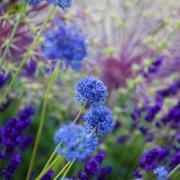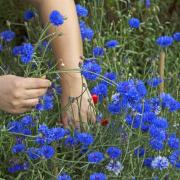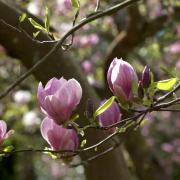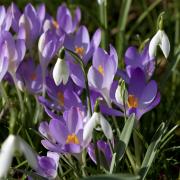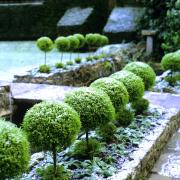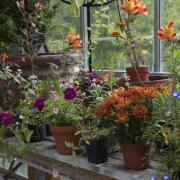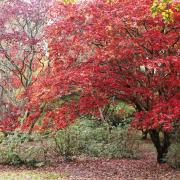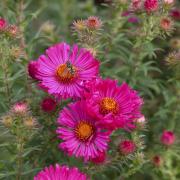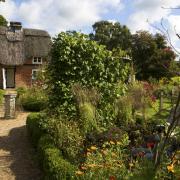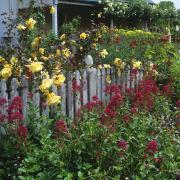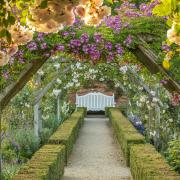Enjoy water meadows and unique views on a tour around one of Hampshire’s most exclusive gardens | Words and Photographs by Leigh Clapp
Home to Elizabeth and Rupert Nabarro since 1994, Bere Mill sits low in the landscape beside the River Test and is first glimpsed as you cross an ancient bridge spanning the pristine waters.
Approximately five acres of gardens stretch out behind the historic house and mill, interspersed by side streams and blending into the water meadows beyond where cattle and sheep graze on the Nabarro’s 100-acre farm.
The whole landscape is run on organic methods and the couple are practically self-sufficient, including water and heating drawn from the river. It comes as no surprise to learn that the unique location with the timeless quality of the landscape was the main draw card to the property, and the then derelict buildings a challenge they took on with enthusiasm.
There has been a mill on the site for seven centuries. The 1712 mill was historically important as the original location where Portals made bank-note paper for the Bank of England, after which uses then changed to flour-making, supplying electricity and in the 1950’s as a fish farm.
The Nabarros set about sympathetically renovating the original house to respect the continuity of the mill buildings. A devastating fire in 2018 has meant a long process again of complete restoration using skilled local craftsmen. At my visit the house had risen from the ashes, with the mill’s completion expected this year, and it will be difficult to see that there had ever been a fire. “We hope to generate electricity as part of our self-sufficiency once the mill’s wheel is restored,” adds Rupert.
It took months when they first moved to the property to reclaim the beauty of the millstreams and lake, which had become muddy and slow, with the laborious removal of silt, brambles and nettles. The resulting crystal clear water with its shimmering reflections brings energy to the environment. “This is as much a landscape as it is a garden and an awful lot of the work done by myself and our three part-time gardeners is mowing and riverbank management. It’s always a work in progress.
“Flooding is not an issue as the Test is fed by a rising aquifer and the river is very controlled with a carefully worked out regime, such as cutting weed at set times along the river. The entire river is a Site of Special Scientific Interest and while looking after the margins and caring for the wild flora and fauna is supervised by Natural England, beyond that it’s up to us to manage the water meadows, hedges and bring trees back into the landscape,” Rupert explains.
As the gardens were not badly damaged by the fire they have continued to be a haven from the stresses of re-building. Developed over the twenty-six years from a few ancient apple trees, the remnant of a wall and a windbreak of seventy-five Leylandii, which was promptly removed, it is keeping the spirit of the location that is the central ethos.
Beech and alder were planted for wind protection, including a line of pleached cut leaved alder that draws the eye down the garden and is accompanied by a timber serpentine bench. A sense of strong lines accompanied by curvaceous forms pervades the design, along with a juxtaposition of contemporary and rustic detailing from sculptural pieces.
The traditional Hampshire wall of crushed chalk between hurdles, capped with terracotta tiles, was rebuilt to create an enclosed orchard and is now home to heritage apples, pears, plums, cherries and peaches.
READ MORE: See more of Hampshire’s great homes and gardens here
The design and evolution of the garden has been a fusion of ideas and influences from Elizabeth and Rupert’s travels, especially to Japan, along with an understanding of the ‘sense of place’ in this extraordinary landscape.
“Gardening is an excellent artistic expression that lends itself to different characteristics. We like the Japanese aesthetic; the garden is loosely fashioned on a Japanese stroll garden. I am very influenced by the idea of the borrowed landscape - the rivers, fields and hills – being reflected in the garden, to make vistas and walkways interesting and blend into the landscape. A garden should never be seen as separate from its surroundings,” comments Rupert, who is the guiding force of the garden.
Working with, and not against the conditions of this location, whether with the alluvial soil or the tendency of winds to tunnel along the valley.
As the driveway is an area of poor, dry ground Mediterranean plants thrive, such as lavender and cistus. The scene then gradually becomes more naturalistic as you progress through the landscape, past double herbaceous borders and block planting in bog gardens, before finishing with a long jetty bridge across the lake and a gate into the fields beyond.
Grassy lawns stretch out with ancient apple trees framing views along the borders, in autumn painted with a tapestry of golds, purples, blues, pinks and russets from a mix of perennials, including rudbeckia, Lobelia x speciosa ‘Hadspen Purple’, Salvia uliginosa, asters, heleniums and chrysanthemums.
Timber walkways cross the streams edged in irises to a delightfully wild assortment of bog plants, such as giant butterbur, gunnera, phormiums, bamboo and miscanthus jostling for the sky, a mix of shades of green, with flashes of colour from semi-tropical cannas, gingers and sunny yellow helianthus.
There are plenty of spots to sit and gaze out at the landscape. Perched comfortably beside the lake is a bespoke teahouse, inspired by a rare Sung dynasty manuscript depicting a scholar’s riverside hut on stilts. It was built by Australian artisan sculptors Paul Jamieson and Rohan Ward on site, out of green oak.
They also constructed a deceptively simple self-supporting bridge, spanning one of the streams, using wedges of a felled local Wellingtonia tree. Providing interest through the year sees a succession of early bulbs, including species tulips and swathes of soft yellow daffodils, through blossom from Japanese prunus, glamorous peonies and the ribbons of irises, to the blowsiness as summer melds into autumn.
At every turn the natural setting and the gentle planting merge together as in an Impressionist painting, and it’s no wonder the garden sees many return visitors each time it opens through the National Garden Scheme.
Don’t forget to follow us on Instagram, Twitter and Facebook




